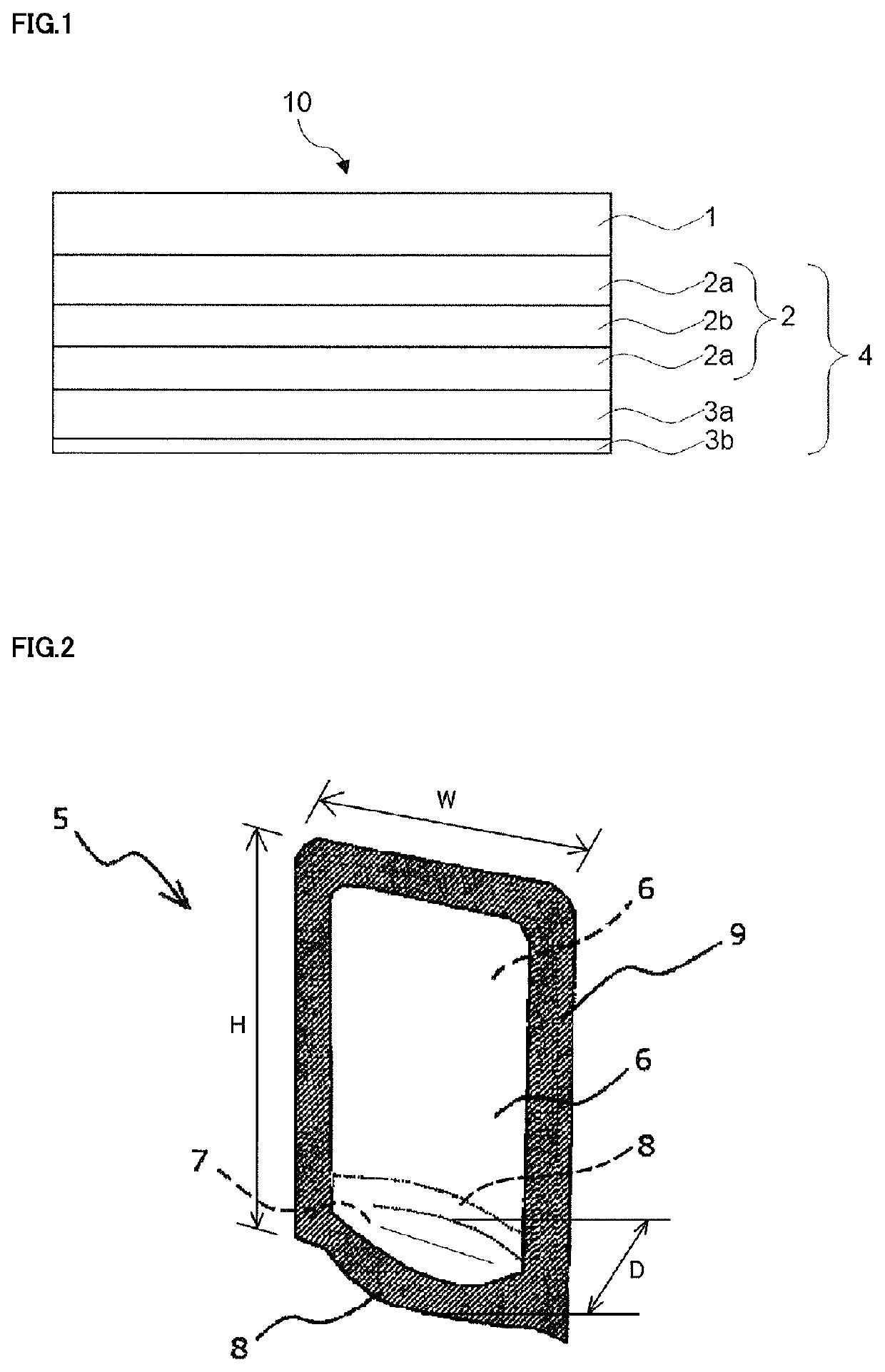Multilayer structure, and standup pouch including the multilayer structure
a multi-layer structure and stand-up pouch technology, applied in the direction of packaging foodstuffs, packaged goods types, synthetic resin layered products, etc., can solve the problem of inability to use the microwave oven, achieve sufficient heat sealing strength, reduce the change rate of gas barrier properties, and reduce water vapor permeability
- Summary
- Abstract
- Description
- Claims
- Application Information
AI Technical Summary
Benefits of technology
Problems solved by technology
Method used
Image
Examples
example 1
[0172]With the use of an inflation multilayer film forming apparatus, a multilayer material having a layer configuration of Ny1 (10 μm) / EVOH (20 μm) / Ny2 (10 μm) / Tie (5 μm) / PP1 (45 μm) / PP2 (10 μm) was prepared. The parenthesized numerals indicate the thicknesses of the respective layers.
(Film Forming Conditions)
[0173]Ny1 layer: 40 mmϕ single-screw extruder (with a barrel temperature of 240° C.)
EVOH layer: 40 mmϕ single-screw extruder (with a barrel temperature of 230° C.)
Ny2 layer: 40 mmϕ single-screw extruder (with a barrel temperature of 260° C.)
Tie layer: 40 mmϕ single-screw extruder (with a barrel temperature of 240° C.)
PP1 layer: 40 mmϕ single-screw extruder (with a barrel temperature of 240° C.)
PP2 layer: 40 mmϕ single-screw extruder (with a barrel temperature of 240° C.)
PE layer: 40 mmϕ single-screw extruder (with a barrel temperature of 240° C.)
die: Spiral die (with a die temperature of 230° C.)
Film folding width: 600 mm
[0174]A multilayer structure was produced by dry-laminat...
example 2
[0176]A multilayer material having a layer configuration of Ny1 (10 μm) / EVOH (20 μm) / Ny1 (5 μm) / Ny2 (10 μm) / Tie (5 μm) / PP1 (35 μm) / PP2 (20 μm) was prepared in substantially the same manner as in Example 1.
[0177]A multilayer structure was produced in substantially the same manner as in Example 1 by laminating the resulting multilayer material on a 12 μm-thick PET1 layer with the Adh applied in an amount of 3 g / m2 between the multilayer material and the PET1 layer.
[0178]The resulting multilayer structure had a layer configuration of PET1 (12 μm) / Adh (3 μm) / Ny1 (10 μm) / EVOH (20 μm) / Ny1 (5 μm) / Ny2 (10 μm) / Tie (5 μm) / PP1 (35 μm) / PP2 (20 μm), and had an overall thickness of 120 μm.
example 3
[0179]A multilayer material having a layer configuration of Ny1 (10 μm) / EVOH (20 μm) / Ny1 (5 μm) / Ny2 (10 μm) / Tie (5 μm) / PP1 (25 μm) / PP2 (30 μm) was prepared in substantially the same manner as in Example 1.
[0180]A multilayer structure was produced in substantially the same manner as in Example 1 by laminating the resulting multilayer material on a 12 μm-thick PET1 layer with the Adh applied in an amount of 3 g / m2 between the multilayer material and the PET1 layer.
[0181]The resulting multilayer structure had a layer configuration of PET1 (12 μm) / Adh (3 μm) / Ny1 (10 μm) / EVOH (20 μm) / Ny1 (5 μm) / Ny2 (10 μm) / Tie (5 μm) / PP1 (25 μm) / PP2 (30 μm), and had an overall thickness of 120 μm.
PUM
| Property | Measurement | Unit |
|---|---|---|
| thickness | aaaaa | aaaaa |
| thickness | aaaaa | aaaaa |
| thickness | aaaaa | aaaaa |
Abstract
Description
Claims
Application Information
 Login to View More
Login to View More - R&D
- Intellectual Property
- Life Sciences
- Materials
- Tech Scout
- Unparalleled Data Quality
- Higher Quality Content
- 60% Fewer Hallucinations
Browse by: Latest US Patents, China's latest patents, Technical Efficacy Thesaurus, Application Domain, Technology Topic, Popular Technical Reports.
© 2025 PatSnap. All rights reserved.Legal|Privacy policy|Modern Slavery Act Transparency Statement|Sitemap|About US| Contact US: help@patsnap.com

